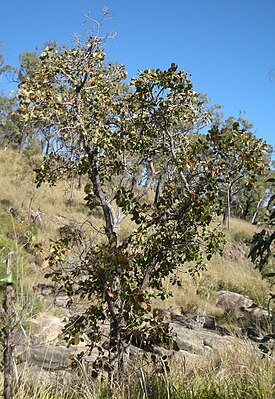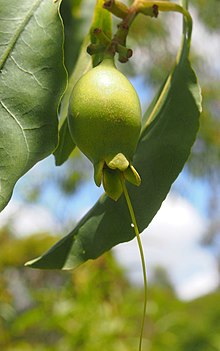Planchonia careya
| Planchonia careya | ||||||||||||
|---|---|---|---|---|---|---|---|---|---|---|---|---|

Planchonia careya |
||||||||||||
| Systematics | ||||||||||||
|
||||||||||||
| Scientific name | ||||||||||||
| Planchonia careya | ||||||||||||
| ( F.Muell. ) R.Knuth |
Planchonia careya is a species of plant in the potted tree family from northwest to northeast Australia and New Guinea . It is also known as cockatoo or cockey apple , in Australia also as wild quince , cockatoo apple or bush mango and billygoat plum .
description
Planchonia careya grows as a small, semi- evergreen tree about 4.5–10 meters or rarely a little more high. The thick, somewhat corky bark is grayish and cracked to furrowed.
The simple, short-stalked and soft-leather, bald and alternate leaves are ovate to rounded or obovate to spatulate. They are more or less notched to almost whole at the edge and rounded to pointed or pointed, less often indented, and about 4–10 centimeters long. The petiole is about 2–3 inches long. When the foliage changes in the dry season, the leaves turn orange-red.
It forms racemose inflorescences with a few flowers. The stalked, hermaphrodite and very short-lived flowers are four-fold with a double flower envelope . The approximately 0.8–1.5 centimeters long flower stalks are fine fluffy. The outside fine fluffy hypanthium is cup-shaped and separated from the flower stalk by a "joint". There are smaller front sheets available. The smaller, fluffy on the outside, soft-leather and somewhat unequal calyx tips are ovate to elongated, rounded to pointed and greenish. The petals are whitish-green and oblong to obovate. The flowers have many (100–140) long, unequal stamens that are fused at the base and reddish to white in the lower part and some staminodes. The multilocular ovary is inferior with a long, slightly conical stylus . There is a ring-shaped disc .
Ellipsoidal to egg-shaped, smooth, green to green-reddish berries (armored berries , false fruit ) with a permanent calyx and long style at the tip are formed. They are up to 4.5–8.5 centimeters in size (without calyx lobes) and contain some, flattened, approximately 7–11 millimeters long, elliptical, orange-brown seeds. The yellowish, creamy pulp lies between fibrous strands.
Taxonomy
The first description of Basionyms Barringtonia careya was made in 1866 by Ferdinand von Mueller in Fragmenta Phytographiæ Australiae 5: 183. The re-allocation to the genus Planchonia was made in 1939 by Reinhard Gustav Paul Knuth in the plant kingdom IV, 219: 56. Other synonyms are Careya arborea var. Australis Benth. , Careya australis (Benth.) F. Muell. , Cumbia australis Britten and Planchonia crenata Miers . The epithet honors the British botanist and missionary William Carey .
use
The fruits are edible, they were valued as bush food by the Aborigines . The bark can be used as a fish poison . The leaves are used medicinally. The light and soft wood has an unpleasant odor.
literature
- Cheryll Williams: Medicinal Plants in Australia. Volume 3: Plants, Potions and Poisons , Rosenberg Pub., 2012, ISBN 978-1-921719-16-5 , pp. 273 f.
- Eric Anderson: Plants of Central Queensland. CSIRO Pub., 2016, ISBN 978-1-4863-0225-3 , p. 247.
- James W. Byng: The Flowering Plants Handbook. Plant Gateway, 2014, ISBN 978-0-9929993-1-5 , p. 393.
- GT Prance, EK Kartawinata: Lecythidaceae. In: Flora Malesiana. Series I, Volume 21, 2013, pp. 1–118, online (PDF; 14.5 MB), at Naturalis repository, accessed on October 3, 2019.
- Barringtoniaceae at Delta.
- Planchonia at FloraBase the Western Australian Flora, accessed October 3, 2019.
Web links
- Planchonia careya from Australian Tropical Rainforest Plants, accessed October 2, 2019.
- Planchonia careya from Australian Native Plants Society (Australia) - ANPSA, accessed October 2, 2019.
- Planchonia careya from Flora Malesiana (with illustration).
- Planchonia careya from Territory Native Plants, accessed October 2, 2019.
Individual evidence
- ↑ Peter K. Endress: Diversity and Evolutionary Biology of Tropical Flowers. Cambridge Univ. Press, 1994, 1996, ISBN 0-521-42088-1 , p. 249.
- ↑ online at biodiversitylibrary.org.
- ↑ Cocky Apple at Turning Trees Into Toothpicks, accessed October 3, 2019.

